From analog to digital: some interesting designers and how to apply them in education
“Here he grows up, and we will collect Arduino and Mindstorms with him,” many probably dream. The problem is that a child will learn a conditional iPad faster.
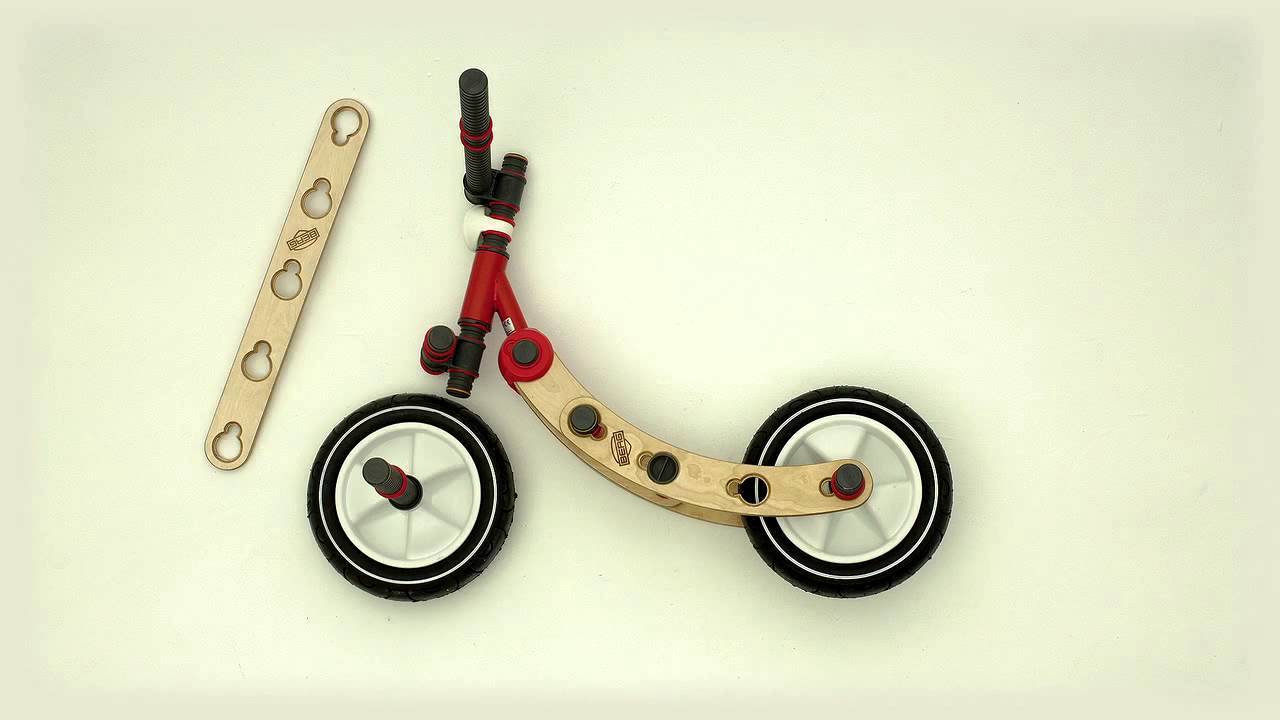
We have collected several recipes on how to distract a child from the screen at an early age (and then return it to the monitor, but already consciously) and instill interest in design in order to develop the right skills . For convenience, we tried to highlight the age categories. And where they could, they found analogues: after all, the taste and color of all the designers are different.
The basis of the post was the experience of the team and users of our constructor.
Background. It all started with an unsuccessful attempt to assemble a motorcycle from the designer “ala Soviet metal” - now there are a lot of them with different names:
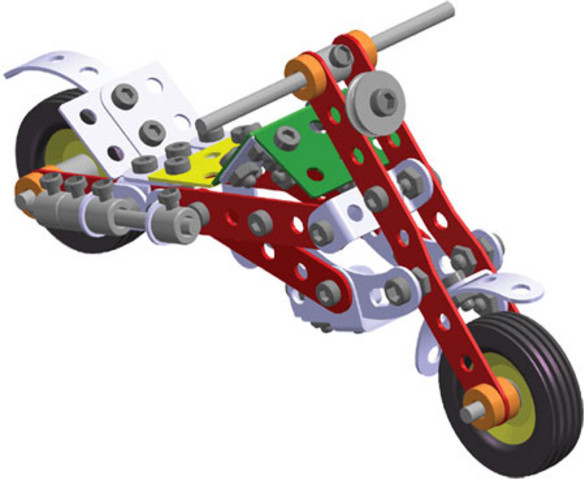
It should have turned out somehow, but the petty one got distracted and ran off to ride a bike along the street. It’s also not bad, but then we thought - is it possible to somehow “catch up” with its constructor in outdoor games?
Experience. If you look, if there is anything street and full-sized on the topic of construction and transport, there is a solution - the Moov set from Berg Toys.

The Dutchmen make such a constructor
. We are just looking at him. Firstly, we decide which of the sets to take: maybe, we will limit ourselves to where the three basic models are for $ 200 (there is also a large set with 10 models for $ 500), excluding delivery.
In the main, we fear how such a thing is adapted to our impassability. Everything bends easily on the video:
What to replace. Surely many in their childhood tried to assemble “their own car” from improvised materials and wheels that fell off the bike.

So you can always try to cut your version of a full-sized transport designer from any suitable material yourself.
Background. We wondered how to instill in the child an interest in working with different materials, repair something and help dad. I wanted "to get home without dirt and danger." So a pseudo-wooden constructor appeared in the family.
Experience. In this constructor, the tree is replaced by an EVA polymer that does not produce sawdust and splinter. And the tools are safe and plastic: saws, a hammer with nails, screwdrivers with screws and even a hand mill. That is, the child can be given without fear.

Part of the models can be assembled according to the instructions enclosed in the box, but usually the child is carried away - and saws something of his own. Or he chooses beautiful models from the packaging for which there is no instruction for them - and in the end also collects models to his taste. With such a thing, a child can easily “stick” for two hours, and then he will also teach you how to screw screws and hammer nails.
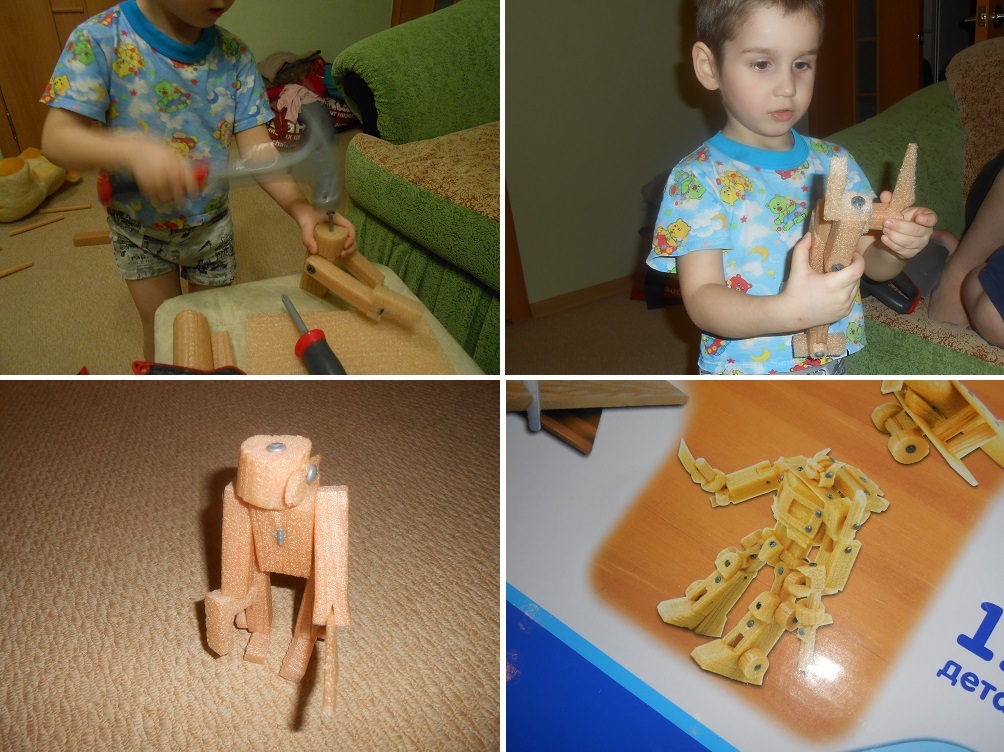
Self-assembly of the "robot".
The plus is that parts can be attached to any length, which you will not achieve in “plastic constructors with a screwdriver”. The downside is that the pieces spent on one model are harder to reuse - they detach easily, but the holes from the plastic nails and screws can not be got anywhere. Such “Young Master” kits are produced under the control of our compatriots (S + S Toys) in China.
What to replace.There are many wooden designers with similar details - planks, bars and round tiles. It’s inconvenient that some interesting sets come without connections.
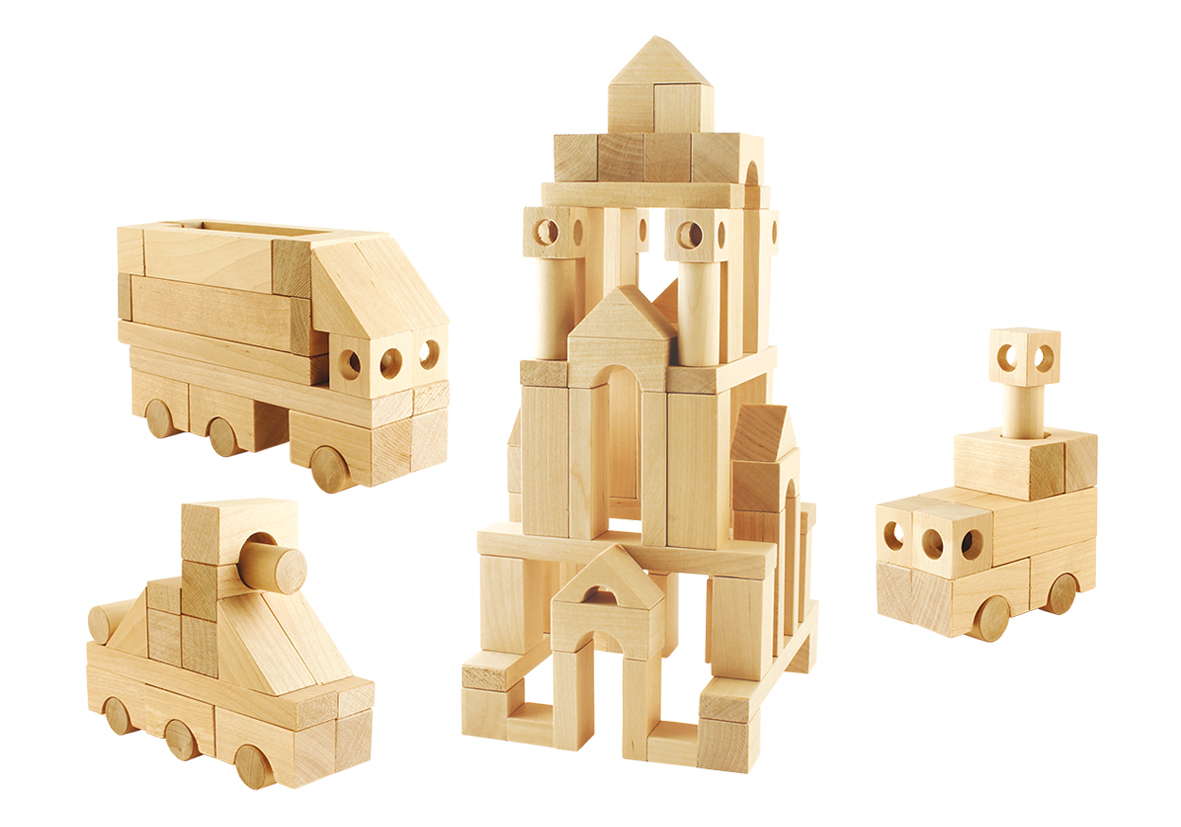
As an example, a large constructor of the Novosibirsk production of Pelsi: birch, without joints. True, pins can be found in smaller kits.
Here either to reconcile, or as the Austrian inventor Johan Korbuli - take a drill and come up with your mount. According to legend, his constructor Matador was born - he drilled cubes and put them on pins so that the youngest son would not scatter the buildings of the older ones. Here is his method:
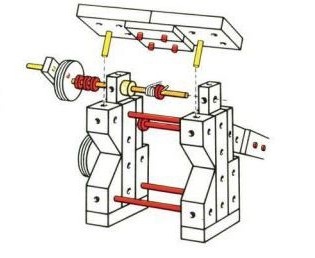
And here is what comes of such sets:
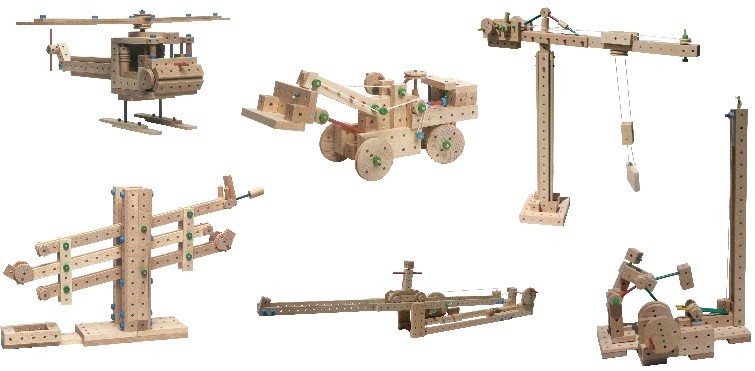
Background. By the age of one and a half years, the son was already with a tablet “on you” and sat down on a toy, where the boy runs from the train on rails. At the same time, he showed us how the freemium model works in applications. To distract, we decided to buy him a “real” railway: to begin with a wooden one, with minimal detail.
Experience. Besides the fact that it’s not so painful to step on a wooden road as on a metal one, the purchase turned out to be a real creative designer. Because the parts can be connected “wrong”. Here is the simplest example:
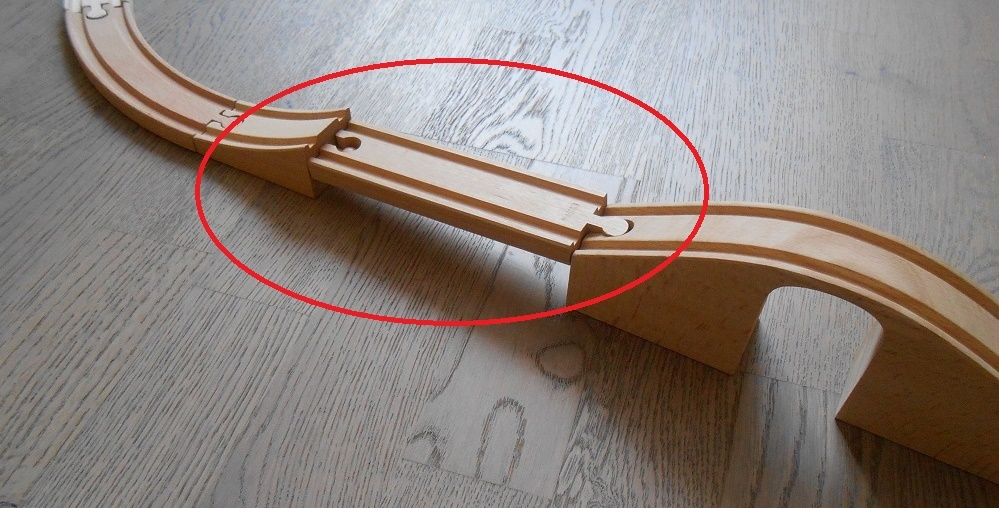
From such “wrong” connections are obtained: a space rocket (entrance to the bridge + straight track, repeat twice), fortifications, houses and so on. However, sometimes for better compatibility, linear fasteners have to be rounded with a sandpaper. The initial road was taken in "Ikea" (20 parts cost a total of six hundred rubles), then the elements for it were bought up at various online stores.
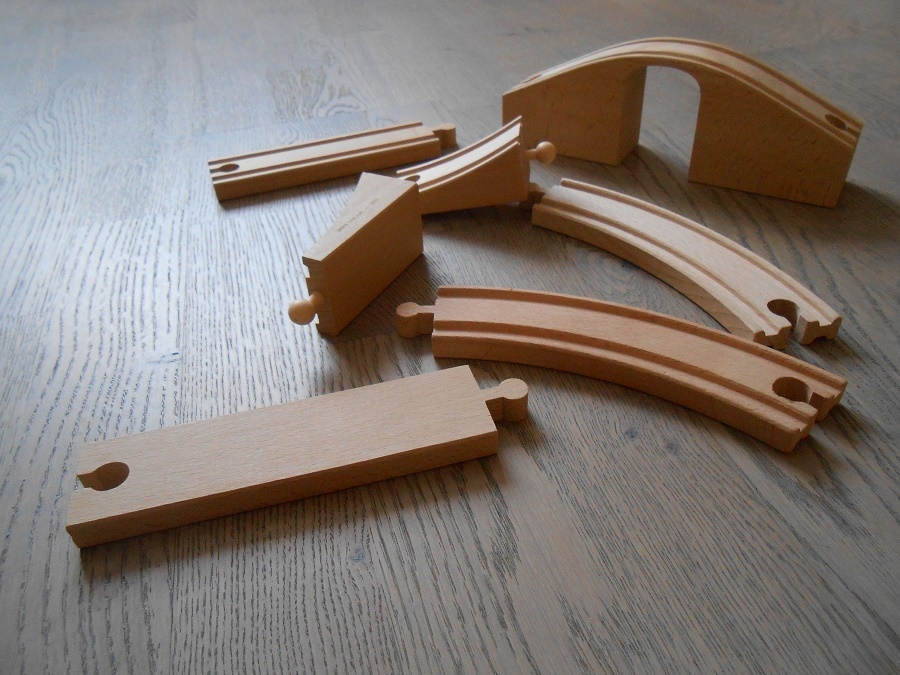
The only negative is that the set of basic elements is limited. But they can be supplemented, for example, with details from the game "Jenga".
Background. Sometimes it happens that you are visiting your grandmother, and your favorite details are not at hand. How to replace?
Experience: 1) Domino Knuckles. To build a house on the carpet from dominoes is a non-trivial task. In addition to spatial thinking, it develops patience on a reasonable scale.
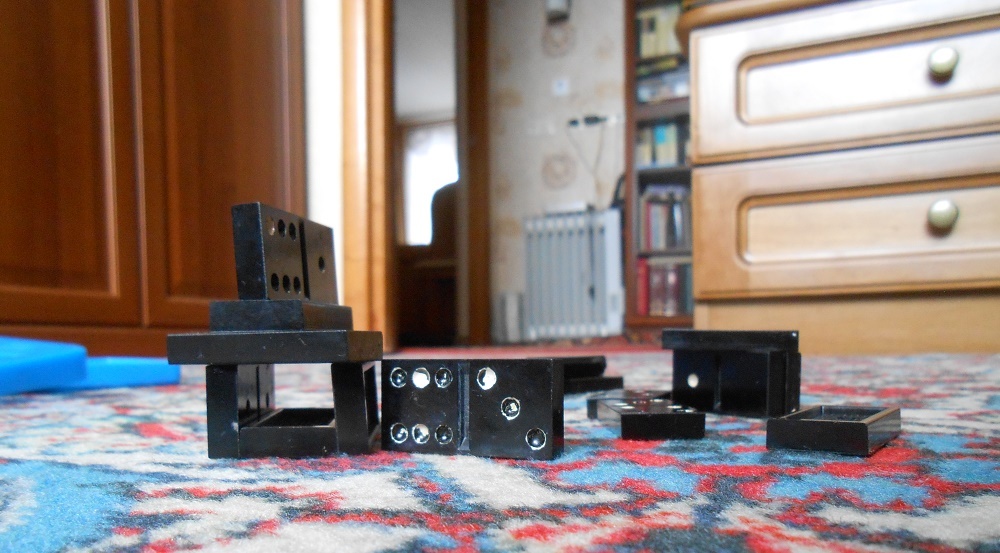
What to replace. If you get carried away with the concept of squashed blocks, like in dominoes, there are more sustainable solutions. For example, Magna Tiles (left) and Magformers (right).

Details in them are connected on magnets. In these sets there are more colors, plus the child studies physics a little.
2) “Inherited constructors”. For example, the parents of our support manager dug up a copy for the grandson:

This is the designer of Mottik, which in the 1990s was sold almost by weight.
His son really likes it, including because “dad played.” So it develops family traditions. Surely many, if you dig around, there are remains of old children's designers. Feel free to let them into business.
Background. Sell it came up with a man with an upturned consciousness - an Australian. We came across a project on Kickstarter, where a man collected pre-orders (from $ 200 to 700, depending on the complexity of the set). Judging by the updates, the production at Squishy Forts has not worked out so far.
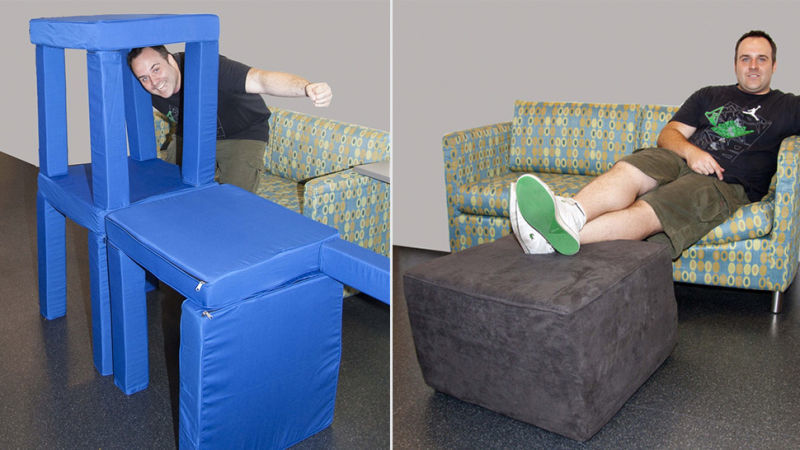
Experience. Of course, we did not think to pre-order. A designer made of furniture and interior items is a great thing that a priori is in any home. Firstly, there is no problem with the compatibility of parts - everything can be used: pillows, rugs, chairs, a sofa. Secondly, the reassembly speed is off the charts.
Thirdly, you can conduct electricity:
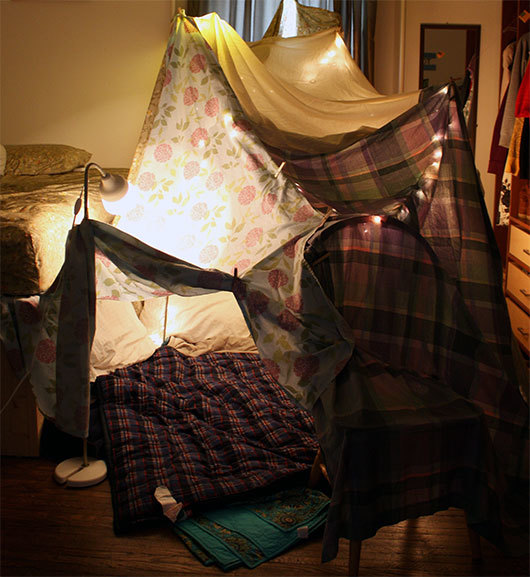
Finally, it works great to distract a child if you have limited his access to the digital world. And helps to accustom to clean up after itself. Which is also important.
Than to replace: it is priceless.
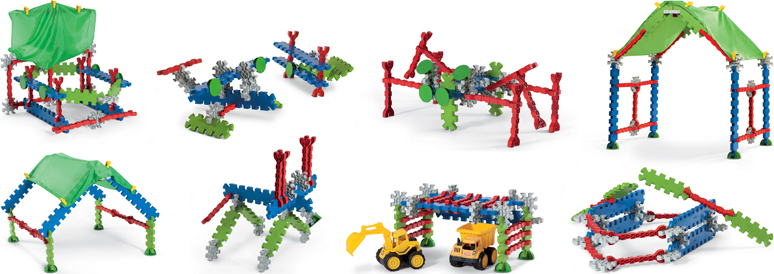
But if you ruin the sofas is still not an option, on the Internet, TikeStix - “a large-sized designer for building houses, shelters and other crafts in baby growth” comes across.
Background. “Gears, Gears, Gears” is a bunch of separate worlds, as in “Lego”, only the idea is built not on cubes, but on gears and platforms for them. We saw it on Amazon, decided that we would show our son how simple mechanisms work. And at the same time we’ll take the first interest in assembling moving platforms - we hope that after some time we will move on to programmable ones.
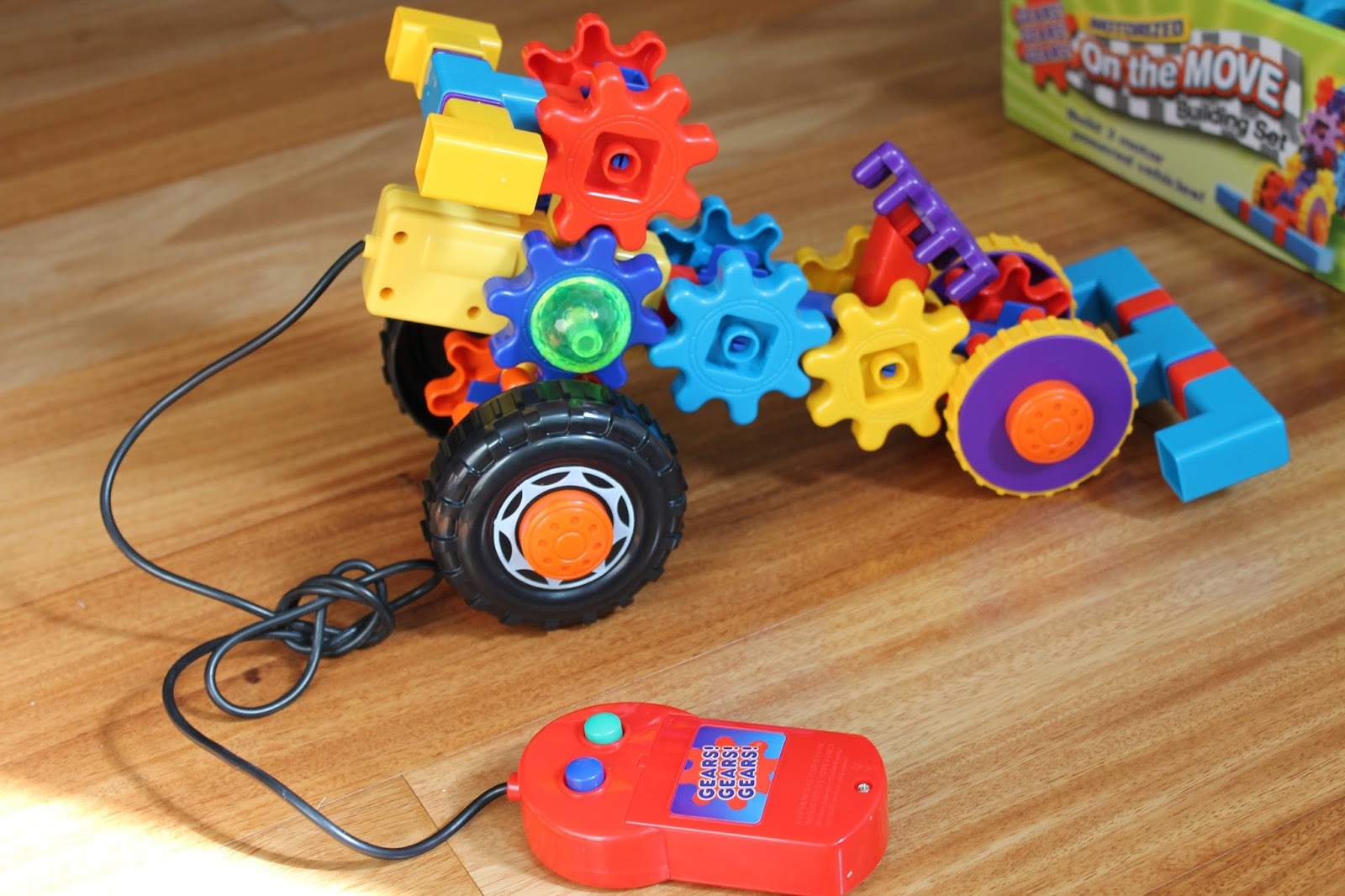
Experience. Such a thing, as in the picture, is coming to us now. The manufacturer has a set with a motor, from which the machine, helicopter and bike are made. All wealth is worth 35 bucks.
Most importantly, gears are here not only for the sake of beauty:
And after the assembly, we will begin to return the child to the digital world - now there are just a lot of logic games about gears.
Background. The current generation of children has gone even deeper into virtual worlds, and it is necessary to compensate for this by using games with benefit.
Experience. It was in our childhood that the sessions of minecraft started at the May holidays with the planting of potatoes. Today, you can come to the world of minecraft directly from Lego - they release theme sets. Well there, Minecraft even has an origami version:
Well, the original game itself is a wonderful digital designer that can generate the same interest that many started in the profession: “Make your own game.”
No wonder Minecraft is now used in children's programming courses. The phrase “programming tortoise fighting robots” sounds great, even if you are not 6-8 years old.
Background. “Make your own website” is probably the equally popular answer to the question “where did your interest in technology begin”, as well as the idea to make your own game. We didn’t think that someone would use our designer to create personal sites or children's pen samples: yes, there are templates with typewriters and it’s enough to move the blocks to start ... but officially we are talking about small business.
Experience. Nevertheless, during the next monitoring of new sites created on the platform, Finn looked at us from one of the pages:
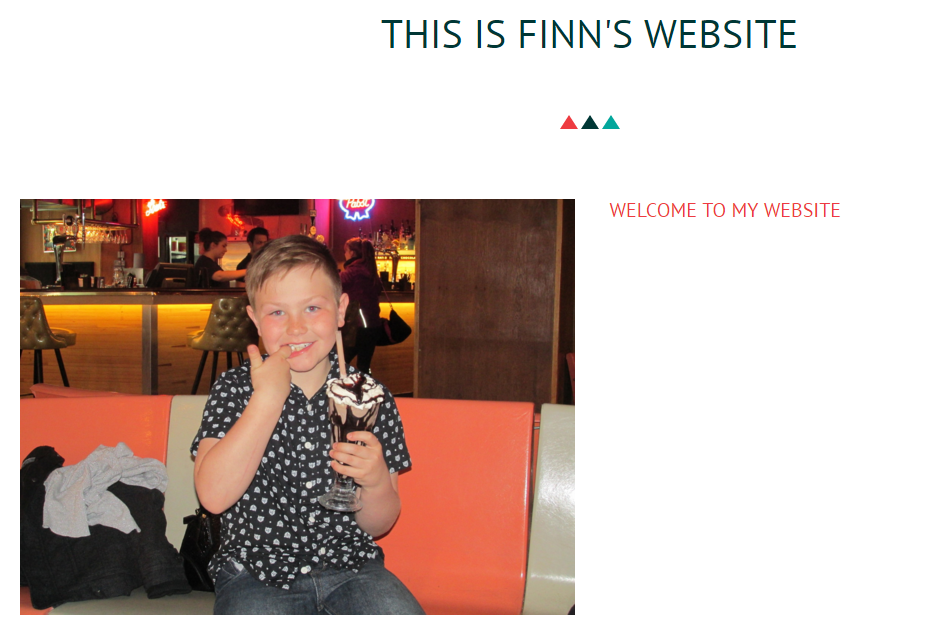
At first we thought that someone was kidding. But the fact is that for English-speaking users there is only a paid version - and the money for the site was debited monthly from someone’s card. We became interested and got in touch. It turned out that the parents decided to keep their son’s school task: “Make a web page”.
The task itself lay in another section of the site. It was a page about Tim Berners-Lee:

Everything is easier in Russian localization - there is a free version. There were also quick examples. Here is the site of nine-year-old Gregory - a young Lego fan who shoots his cartoons with the characters of the designer:

He sat down on designers since childhood (which has not yet ended), in the digital world, Minecraft respects most of all. The teenage online fashion for vlogging (video blogging) also touched him, but Grisha decided not to show any garbage, but took out his “Lego”, began to master photo and video editors - and now he’s making cool video notes about how make the lego figure move and bounce in the frame.
The site started, because the whole project proudly calls a "studio". And the studio should have a website. And for some reason we think that the guy will work out well.
PS And how do you maintain a balance between digital and offline activities in your family? What designers do you use “for education”?

We have collected several recipes on how to distract a child from the screen at an early age (and then return it to the monitor, but already consciously) and instill interest in design in order to develop the right skills . For convenience, we tried to highlight the age categories. And where they could, they found analogues: after all, the taste and color of all the designers are different.
The basis of the post was the experience of the team and users of our constructor.
(6+) Constructor of transport
Background. It all started with an unsuccessful attempt to assemble a motorcycle from the designer “ala Soviet metal” - now there are a lot of them with different names:

It should have turned out somehow, but the petty one got distracted and ran off to ride a bike along the street. It’s also not bad, but then we thought - is it possible to somehow “catch up” with its constructor in outdoor games?
Experience. If you look, if there is anything street and full-sized on the topic of construction and transport, there is a solution - the Moov set from Berg Toys.

The Dutchmen make such a constructor
. We are just looking at him. Firstly, we decide which of the sets to take: maybe, we will limit ourselves to where the three basic models are for $ 200 (there is also a large set with 10 models for $ 500), excluding delivery.
In the main, we fear how such a thing is adapted to our impassability. Everything bends easily on the video:
In general, the Dutch have many funny and rather expensive ideas: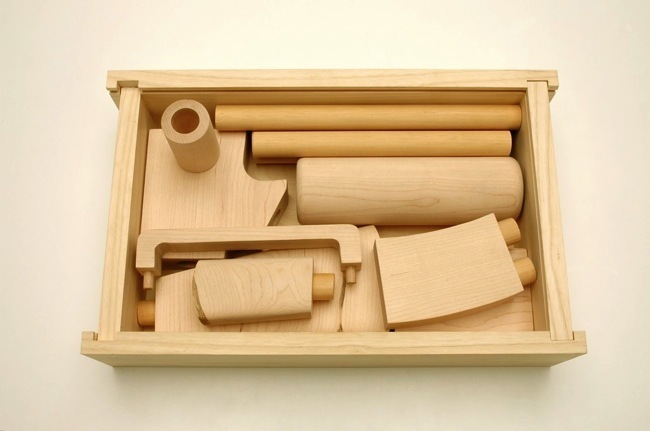
In the picture, Ratata is a pseudo-constructor of weapons for 185 euros.

In the picture, Ratata is a pseudo-constructor of weapons for 185 euros.
What to replace. Surely many in their childhood tried to assemble “their own car” from improvised materials and wheels that fell off the bike.

So you can always try to cut your version of a full-sized transport designer from any suitable material yourself.
(4+) Pseudo-wooden constructor
Background. We wondered how to instill in the child an interest in working with different materials, repair something and help dad. I wanted "to get home without dirt and danger." So a pseudo-wooden constructor appeared in the family.
Experience. In this constructor, the tree is replaced by an EVA polymer that does not produce sawdust and splinter. And the tools are safe and plastic: saws, a hammer with nails, screwdrivers with screws and even a hand mill. That is, the child can be given without fear.

Part of the models can be assembled according to the instructions enclosed in the box, but usually the child is carried away - and saws something of his own. Or he chooses beautiful models from the packaging for which there is no instruction for them - and in the end also collects models to his taste. With such a thing, a child can easily “stick” for two hours, and then he will also teach you how to screw screws and hammer nails.

Self-assembly of the "robot".
The plus is that parts can be attached to any length, which you will not achieve in “plastic constructors with a screwdriver”. The downside is that the pieces spent on one model are harder to reuse - they detach easily, but the holes from the plastic nails and screws can not be got anywhere. Such “Young Master” kits are produced under the control of our compatriots (S + S Toys) in China.
What to replace.There are many wooden designers with similar details - planks, bars and round tiles. It’s inconvenient that some interesting sets come without connections.

As an example, a large constructor of the Novosibirsk production of Pelsi: birch, without joints. True, pins can be found in smaller kits.
Here either to reconcile, or as the Austrian inventor Johan Korbuli - take a drill and come up with your mount. According to legend, his constructor Matador was born - he drilled cubes and put them on pins so that the youngest son would not scatter the buildings of the older ones. Here is his method:

And here is what comes of such sets:

(2+) Railway
Background. By the age of one and a half years, the son was already with a tablet “on you” and sat down on a toy, where the boy runs from the train on rails. At the same time, he showed us how the freemium model works in applications. To distract, we decided to buy him a “real” railway: to begin with a wooden one, with minimal detail.
Experience. Besides the fact that it’s not so painful to step on a wooden road as on a metal one, the purchase turned out to be a real creative designer. Because the parts can be connected “wrong”. Here is the simplest example:
From such “wrong” connections are obtained: a space rocket (entrance to the bridge + straight track, repeat twice), fortifications, houses and so on. However, sometimes for better compatibility, linear fasteners have to be rounded with a sandpaper. The initial road was taken in "Ikea" (20 parts cost a total of six hundred rubles), then the elements for it were bought up at various online stores.
The only negative is that the set of basic elements is limited. But they can be supplemented, for example, with details from the game "Jenga".
(3+) Life hack: if there is no “Lego” at hand ...
Background. Sometimes it happens that you are visiting your grandmother, and your favorite details are not at hand. How to replace?
Experience: 1) Domino Knuckles. To build a house on the carpet from dominoes is a non-trivial task. In addition to spatial thinking, it develops patience on a reasonable scale.
What to replace. If you get carried away with the concept of squashed blocks, like in dominoes, there are more sustainable solutions. For example, Magna Tiles (left) and Magformers (right).

Details in them are connected on magnets. In these sets there are more colors, plus the child studies physics a little.
2) “Inherited constructors”. For example, the parents of our support manager dug up a copy for the grandson:

This is the designer of Mottik, which in the 1990s was sold almost by weight.
His son really likes it, including because “dad played.” So it develops family traditions. Surely many, if you dig around, there are remains of old children's designers. Feel free to let them into business.
(2+) Designer of pillows
Background. Sell it came up with a man with an upturned consciousness - an Australian. We came across a project on Kickstarter, where a man collected pre-orders (from $ 200 to 700, depending on the complexity of the set). Judging by the updates, the production at Squishy Forts has not worked out so far.

Experience. Of course, we did not think to pre-order. A designer made of furniture and interior items is a great thing that a priori is in any home. Firstly, there is no problem with the compatibility of parts - everything can be used: pillows, rugs, chairs, a sofa. Secondly, the reassembly speed is off the charts.
Thirdly, you can conduct electricity:

Finally, it works great to distract a child if you have limited his access to the digital world. And helps to accustom to clean up after itself. Which is also important.
Than to replace: it is priceless.

But if you ruin the sofas is still not an option, on the Internet, TikeStix - “a large-sized designer for building houses, shelters and other crafts in baby growth” comes across.
(4+) Gear Designer
Background. “Gears, Gears, Gears” is a bunch of separate worlds, as in “Lego”, only the idea is built not on cubes, but on gears and platforms for them. We saw it on Amazon, decided that we would show our son how simple mechanisms work. And at the same time we’ll take the first interest in assembling moving platforms - we hope that after some time we will move on to programmable ones.
Experience. Such a thing, as in the picture, is coming to us now. The manufacturer has a set with a motor, from which the machine, helicopter and bike are made. All wealth is worth 35 bucks.
Most importantly, gears are here not only for the sake of beauty:
And after the assembly, we will begin to return the child to the digital world - now there are just a lot of logic games about gears.
(6-8 +) Minecraft
Background. The current generation of children has gone even deeper into virtual worlds, and it is necessary to compensate for this by using games with benefit.
Experience. It was in our childhood that the sessions of minecraft started at the May holidays with the planting of potatoes. Today, you can come to the world of minecraft directly from Lego - they release theme sets. Well there, Minecraft even has an origami version:
Well, the original game itself is a wonderful digital designer that can generate the same interest that many started in the profession: “Make your own game.”
No wonder Minecraft is now used in children's programming courses. The phrase “programming tortoise fighting robots” sounds great, even if you are not 6-8 years old.
(9+) Website builder
Background. “Make your own website” is probably the equally popular answer to the question “where did your interest in technology begin”, as well as the idea to make your own game. We didn’t think that someone would use our designer to create personal sites or children's pen samples: yes, there are templates with typewriters and it’s enough to move the blocks to start ... but officially we are talking about small business.
Experience. Nevertheless, during the next monitoring of new sites created on the platform, Finn looked at us from one of the pages:

At first we thought that someone was kidding. But the fact is that for English-speaking users there is only a paid version - and the money for the site was debited monthly from someone’s card. We became interested and got in touch. It turned out that the parents decided to keep their son’s school task: “Make a web page”.
The task itself lay in another section of the site. It was a page about Tim Berners-Lee:

Everything is easier in Russian localization - there is a free version. There were also quick examples. Here is the site of nine-year-old Gregory - a young Lego fan who shoots his cartoons with the characters of the designer:

He sat down on designers since childhood (which has not yet ended), in the digital world, Minecraft respects most of all. The teenage online fashion for vlogging (video blogging) also touched him, but Grisha decided not to show any garbage, but took out his “Lego”, began to master photo and video editors - and now he’s making cool video notes about how make the lego figure move and bounce in the frame.
The site started, because the whole project proudly calls a "studio". And the studio should have a website. And for some reason we think that the guy will work out well.
PS And how do you maintain a balance between digital and offline activities in your family? What designers do you use “for education”?
